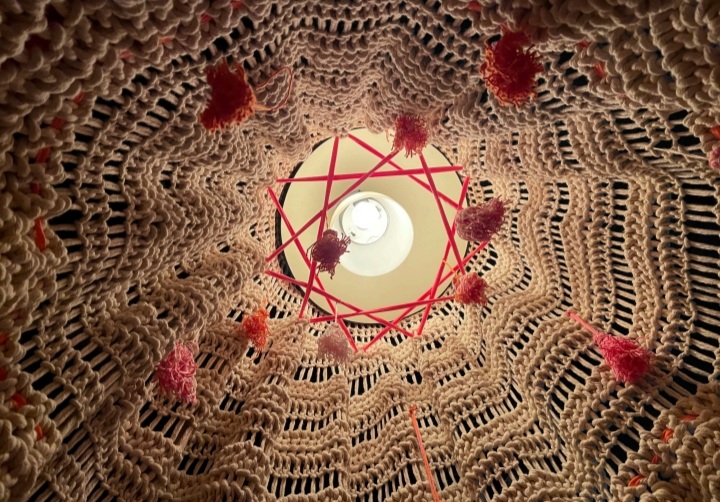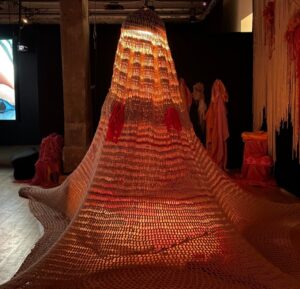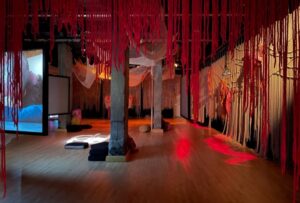Thierry Huard’s newest project is an expansive exposition on identity and the limitations of relationships
Entering les liens feels like stumbling upon a labyrinth of knitted sweaters and yarn. The MAI’s transformed art gallery is draped in cotton strings from wall to ceiling. Warm lighting and ambient soundscapes make for a space of introspection and comfort. It’s as if the threads function as safety netting from the exterior world.
As described by the exhibit’s creator, Thierry Huard, the intention behind the exhibit is to portray “A queer and kaleidoscopic vision of friendship, of one’s relationship to the self and to others.”
The walkthrough is organized into 10 sections, each offering a new perspective of Huard’s artwork. Cushions are scattered on the floor, inviting visitors to sit and rest while contemplating concepts around relationships and identity.Multiple screens accompany the strings, showing footage of Huard and his colleague, Nate Yaffe, as they explore what is and isn’t possible while entangled in threads. They stretch together, wrestle, and suspend in time as they hold each other.
Yaffe fits into the themes of the exhibit as an experimental dancer who specializes in relational and queer-centred choreography.
While watching these individuals, I imagine they are attempting to break free from the tangled and restricting nature of heterosexual norms. Queer individuals are often tasked with unraveling these loose threads as they adjust to a world that feels new and undefined.
After recently entering my first queer relationship, I felt worried in the beginning I would have to adjust to new expectations. Eventually, I realized it was the total opposite, and found an openness and acceptance where I can be myself. I think that sentiment is what this exhibit is about.
Further to the back of the gallery hang two knitted silhouettes; their upper bodies are incomplete with loose, hanging threads. In fact, many of the handknit structures are unfinished, a testament to the continuous exploration of one’s queer identity.
The most magical part of the labyrinth is the hanging tent. Within the tent is a sleeping bag, drawings, and written prompts. While laying on the bedding with a friend, we asked each other questions like, “What would you want to be your superpower?” and “Do you believe everyone has a purpose in life? If so, what do you believe your purpose is?”
The tent has cutouts of strange symbols in it, and after further exploration, these symbols could be found everywhere – sewn into the tent, on the walls, and projected onto the floor. These hieroglyphic monograms speak a language which could only be deciphered by the two characters of the exhibit.
Upon reading the gallery plan, it became clear that these symbols all represented themes of love, such as deep trust, self-forgiveness, and universal love.
The acrylic drawings at the gallery’s exit show two unfinished faces which seem to stare at each other through knitted bandages. Although these faces are incomplete, their gestures clearly show their affection for each other.
Huard’s immersive experience brings forward a warm feeling. The same feeling as a loving embrace or a comfy armchair. The resulting ambience allows viewers to open their mind in peaceful reflection.
Visuals courtesy Curtis Savage






